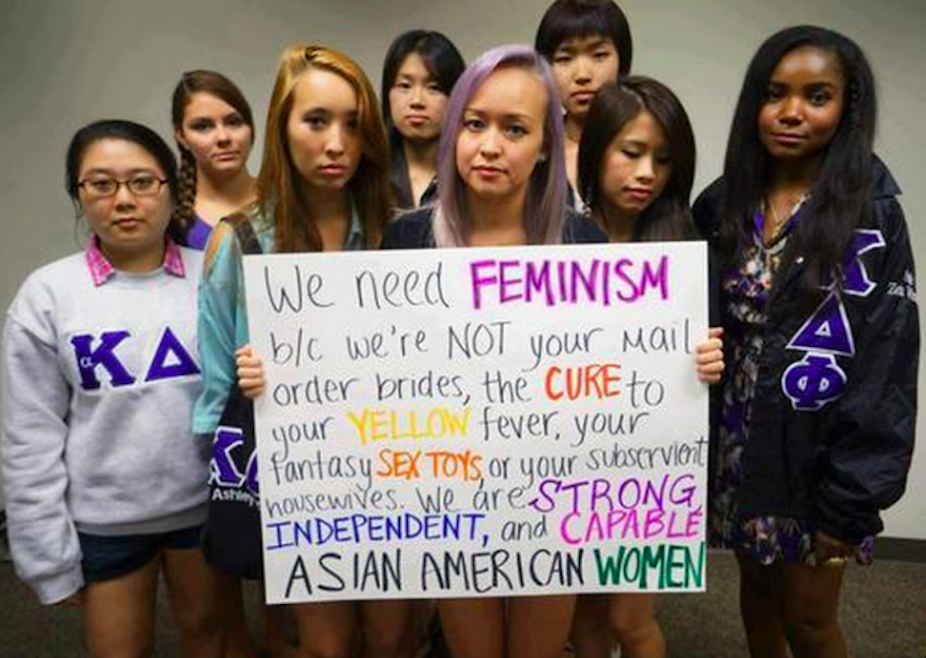In December, I was catching up with a friend over a few glasses of wine. My friend is a white male in his 60s. A passer-by, also a white male, about the same age, stopped by our table. It quickly became obvious that he assumed we were on a romantic date, implying, not so subtly, that my friend was very lucky to have snagged a younger Asian woman.
He proceeded to ask us both where we were from to which, I responded, “Why does it matter?” My friend said he is from Melbourne and so did I. The man continued to linger and asked me again, “Where are you from?” I became very silent and eventually he left.
Not your Asian sidekick
A recent movement for Asian American women’s rights is trending globally. It started on December 15 with a hashtag, “not your Asian sidekick”. Suey Park (@suey_park), the Korean American freelance writer behind the hashtag, explains that she started the conversation to confront persistent stereotypes based on race and gender that Asian American women experience every day. Australia needs to be part of this conversation.
I have been dealing with a garden variety of female Asian stereotypes since I was six years old. These include the perpetual international student, exotic “oriental”, submissive mail-order bride, escort and so on. I was adopted from South Korea into a white American family and so this experience of being marginalised, othered and exoticised by other people is unfortunately not unusual.
Why stereotypes are a big deal
Often, people who have not experienced the damaging effects of these stereotypes ask why I am upset about it. Sometimes, they even say, “It’s not as bad as [insert racist slur]”. The problem is racism comes in all forms and manifests across individual, interpersonal, institutional and structural levels.
At an interpersonal level, both blatant and subtle forms of racism are damaging. The harm includes negative health effects such as anxiety, depression, lower self-esteem and high blood pressure.
However, research has found that the subtle variety can be even more harmful because it is harder to identify, is often unintentional and unconscious and happens in very banal everyday contexts.
The problem with stereotypes is that they are so ingrained and so commonplace that they have become invisible. They can be perceived as harmless and as comfortable and normal as your living room chair - except of course if you are on the receiving end.
Another response to these experiences that I get is “just ignore it”, or “they don’t know any better”. Herein lies the privilege of whiteness.
Racism is not about morality. It is not about being a good or bad person. We all hold prejudices and biases regardless of our personal background and are a product of being socialised to think in particular ways.
As a result, “well-meaning” people can also be racist, not just the “rednecks” portrayed in media. However, when talking about racism, we also need to talk about privilege. White people hold the majority position of power in society because they have the privilege of being seen as normal.
Advice to ignore racism or pass it off as “just” ignorance supports the perpetrator by being complicit with that person’s views. By not speaking up and challenging the person to think differently, we allow it to continue unopposed as if it is the majority view.
What we can do about it
The experience of racism is bad enough, but it is even harder when no-one offers support or, even worse, when the perpetrator is supported or excused. Being the victim and the defender is a difficult and disempowered position to be in.
While it might seem like a logical response, colour-blindness is actually not helpful. To be colour-blind is basically to pretend that race is not an issue in society and that people don’t notice race. Ignoring race or pretending it is not a significant social factor does nothing to address social injustice when those perpetrating racism are well aware of its existence (for example, the fact that a young Asian woman is in the company of an older white man).
So what can we do? Doing something does not always have to be a confrontation. You can make it clear that you don’t agree with the person’s views. You can ask the victim if they are okay and try to support them.
Importantly, we all need to challenge ourselves everyday when stereotypes and prejudices creep into our mind. Rather than ignoring them, we need to think and respond critically, creatively and reflexively.

